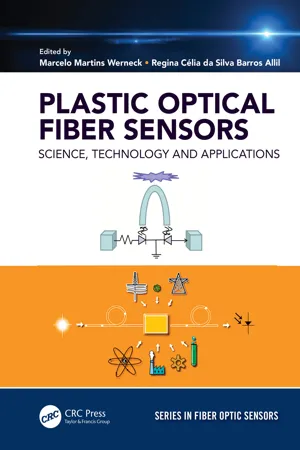![]()
1
Introduction
Why Plastic Optical Fibers?
Hui Pan
Contents
1.1 Why Plastic Optical Fibers?
1.2 History and Evolution of Polymer Optical Fibers
1.3 Silica vs. Polymer Fibers
1.4 POF Markets and Applications
1.4.1 Automotive
1.4.2 Avionics
1.4.3 Consumer Electronics
1.4.4 Interconnection
1.4.5 Industrial Controls and IoT
1.4.6 Home Networking
1.4.7 Medical and Sensors
1.4.8 Homeland Security
1.5 POF Activities, Organizations, and Global Centers of Research and Education
1.5.1 POF in Japan
1.5.2 POF in the United States
1.5.3 POF in France
1.5.4 POF in Germany
1.5.5 POF in European Union (EU)/European Commission (EC)
1.5.6 POF in the United Kingdom
1.5.7 POF in Spain
1.5.8 POF in Portugal
1.5.9 POF in the Netherlands
1.5.10 POF in Brazil
1.5.11 POF in Korea
1.5.12 POF in Australia
1.5.13 POF in Greater China
1.5.14 POF in Other Countries
1.6 POF Resources
1.6.1 Proceedings of International Conference on Plastic Optical Fibers
1.6.2 Proceedings of POF World and POF Symposium
1.6.3 POF Market Reports and Newsletters
1.6.4 Select Books on Plastic Optical Fibers
Acknowledgments
References
1.1 Why Plastic Optical Fibers?
Plastic optical fibers (POFs) compete with copper wires, coaxial cables, glass optical fibers, and wireless, and they require a transmitter, receiver, cables, and connectors similar to those used in glass optical-fiber links. Manufacturers form POFs out of plastic materials such as polystyrene, polycarbonates, and polymethyl methacrylate (PMMA). These materials have transmission windows in the visible range (520–780 nm). However, the loss of light transmitted at these wavelengths is high, ranging from 150 dB/km for PMMA to 1,000 dB/km for polystyrene and polycarbonates. These losses often handicap plastic fibers in competing against high-quality glass fibers, which have losses of 0.2 dB/km for a single-mode fiber and less than 3 dB/km for multimode fibers. Hence, plastic fibers have been relegated to short-distance applications, typically of a few hundred meters or less, compared with the hundreds of kilometers for glass. Nonetheless, POFs have found many applications in areas such as automobiles, airplanes, consumer electronics, industrial controls, short data links, sensors, signs, and illuminations. Basically, POF applications are divided into data communication and non-data applications such as sensors and signs. Today, the growth in POF production stems from its use in data transmission.
There are both advantages and disadvantages of plastic optical fibers versus glass fiber and copper wire [1]. Certain users find POF systems provide benefits compared to glass fiber or copper wire, which include:
Simpler and less expensive components
Operation in the visible spectrum
Greater flexibility, and resilience to bending, shock, and vibration
Immunity to electromagnetic interference (EMI)
Ease in handling and connecting (POF diameters are 1 mm compared with 8–100 microns for glass)
Use of simple and inexpensive test equipment
Greater safety than glass fibers as glass requires a laser light source
Transceivers require less power than copper transceivers
With these advantages come disadvantages that researchers and manufacturers are working to overcome. They include:
High loss during transmission
Small number of systems and suppliers
A lack of awareness among users of how to install and design with POFs
Lack of major funding for research and education
Certification programs from POF installers are incomplete
Lack of high temperature fibers (125°C)
As the market for POF develops further, progress is being made by researchers and POF companies to overcome these challenges.
1.2 History and Evolution of Polymer Optical Fibers
Plastic optical fibers were first developed by DuPont in the early 1960s. The first fibers were made of polystyrene and acrylics which had high loss—on the order of 500–1,000 dB/km—and were used mainly for light guides in short-distance illumination applications. Some of the first applications were in automobiles for the lighting of dashboards. In 1968, DuPont reported the first results of plastic fibers manufactured using polymethyl methacrylate (PMMA) base material. After many years of development, Du Pont decided in 1978 to sell the POF business to Mitsubishi Rayon of Japan. The losses of the PMMA POF were 1000 dB/km when Du Pont sold the business to Mitsubishi Rayon. Mitsubishi Rayon, over the next few years, was able to reduce the loss of the PMMA fibers to close to the theoretical limit of 150 dB/km at 650 nm. This was a step index fiber with a bandwidth of 50 Mbps over 100 meters.
The next major development was by Prof. Yasuhiro Koike and colleagues at Keio University who developed a process to manufacture graded index POF (GI-POF) using PMMA material in 1990. Koike and his colleagues reported a bandwidth of 3 GHz-km with losses of 150 dB/km at 650 nm. The development by Koike solved the bandwidth problem of the step index PMMA POF, but losses were still high.
The next major development was a graded index perfluori...















